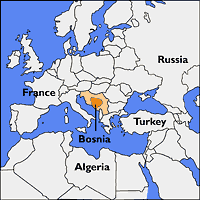|
Bosnia-Herzegovina is a mountainous country about a third the size of England. It lies next to the Adriatic Sea, to the south of Croatia and west of Serbia. Its population is less than half that of London. Bosnia was part of the Ottoman (Turkish) Empire until 1878 and then of the Austro-Hungarian Empire until the First World War. After the war it was united with other Slav territories to form Yugoslavia, essentially ruled and run by Serbs from the Serbian capital, Belgrade. By 1980 the population of Bosnia consisted of 1.3m Bosnian Serbs (Orthodox Catholic Christians), over 1m Bosniaks (Sunni Muslim), and 0.7m Bosnian Croats (Roman Catholic Christians), all with strong historical and local claims to a homeland there.
In 1980 Yugoslavia's communist president Tito died. His rule had held the federation together. Now Croats and Bosniaks began to look for independence, and Serbian nationalism, never dead, took on a new lease of life from 1987 when Slobodan Milosevic became Serbia's leader (and thus effectively Yugoslavia's as well). He encouraged Serb nationalism not only at home but also in the other republics where there were large Serb communities.
Elections in 1990 brought nationalists to power in Croatia and Slovenia, which, together with Macedonia, declared independence in 1991 and were all recognised internationally. Alija Izetbegovic, the leader of Bosnia's multi-ethnic government, called for independence for Bosnia, too; it was recognised as independent by the USA and the EU in 1992.
Bosnia's Serbs, however, weren't happy: they saw themselves and the land they lived on as part of Milosevic's 'Greater Serbia'. The Yugoslav Army (mainly Serb) had just ended a year's fierce conflict with Croatia in an attempt to hang on to Serb communities there. Now it turned its attention to Bosnia, whose forces were restricted by an arms embargo because of recent violence in Bosnian Croatian territory. By the end of 1993 the Serbs (led by Radovan Karadzic) had set up their own Republika Srpska in the east and a Bosnian Serb army (under Ratko Mladic) was in control of nearly three quarters of the country; the Bosnian Croats had been mostly driven out, though a small force continued fighting for its Bosnian territory until 1994; the Bosniaks were hanging on only in the towns.
The European Union (EU) tried mediation, without success. The UN refused to intervene, apart from providing some troop convoys for humanitarian aid. Later its peace-keeping force, UNProFor, undertook to protect 6 'safe areas', mainly Muslim and including Sarajevo (the Bosniak capital) and Srebrenica; it failed. Each so-called safe area, except Sarajevo, fell to the Serbs and was 'ethnically cleansed'. This was the Serbian term accepted by the USA and other members of the UN Security Council to avoid any reference to 'genocide', which would by international law demand their intervention. It had become clear that what was happening in Bosnia was no longer a civil war fuelled by 'ancient feuds', if it ever had been. Bosnia was the victim of one group's determined wish for political domination, which it was prepared to achieve by isolating ethnic groups and if necessary exterminating them.
|
|
 |

